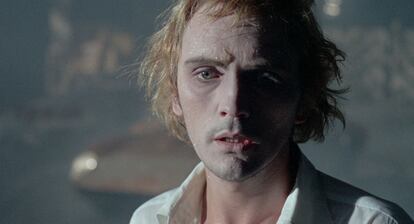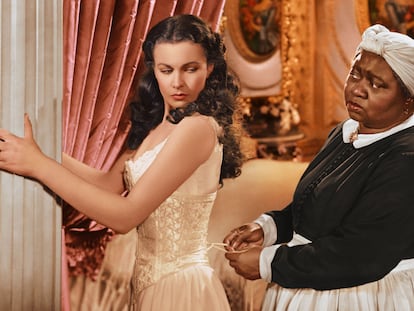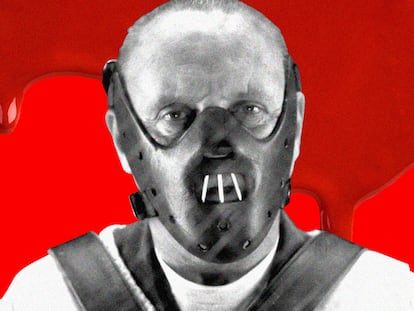Federico Fellini’s forgotten Western
In Italy, the Spanish filmmaker Juan Manuel Chumilla-Carbajosa discovered 197 pictures and an original script that belonged to Fellini. He has since documented what was the legendary Italian director’s only foray into the genre

At the start of 2020—a couple of weeks before the pandemic—the Spanish filmmaker Juan Manuel Chumilla-Carbajosa bought nearly 200 black and white negatives in an old bookstore in the Roman neighborhood of Trastevere. Holding them up to the light, he thought he could make out Federico Fellini wearing a cowboy hat in a town in the Wild West. When he developed them, he also saw a stagecoach drawn by white horses, an actor dressed as a cowboy… and a very young Terence Stamp waving from a car, in the middle of a set filled with gangsters.
Chumilla-Carbajosa, who studied at the Italian capital’s Experimental Film Center and has long been in love with the Italian filmmaker’s work, was quick to associate these images with the deleted sequence from the final montage of Toby Dammit, a film that was shot by Fellini in 1967.
The 46-minute short—which makes up a part of the film titled Extraordinary Tales—is a Franco-Italian co-production starring Terence Stamp. The film tells the story of Toby Dammit: an attractive and sinister English actor, who travels to Rome to receive an award and meet some producers, who are linked to the Vatican and have hired him to star in the first Catholic Western flick in history. The film is very loosely inspired by Edgar Allan Poe’s short story, Never Bet the Devil your Head.
Since his student years, Chumilla-Carbajosa has been obsessed with this Fellini film, which some scholars consider to be one of his fundamental works. His passion for the Italian filmmaker prompted him to document the ghost sequence that was never included in the film, which represents Fellini’s only foray into the Western genre.
In the documentary search process, the Spaniard turned to Leopoldo Santovincenzo, a journalist from Radiotelevisione Italiana (RAI) who is also an expert in the director’s work. In addition to the forgotten photographs, they found a report on the filming of the movie, broadcast by RAI in November 1968. These appear to be the only visual testimonies of this unique Fellinian incursion into a genre that, in the mid-1960s, was experiencing a boom. Classic “spaghetti” Western titles such as The Good, the Bad and the Ugly were filmed in Almería, southern Spain, but permanent sets of towns from the American West were erected at the Elios studios in Rome, to be used for this type of filming.

“I have to make a very honest confession: those two days that I was in the studios where this [American Western] town is permanently built, I enjoyed them very much—I’m envious of my colleagues who make these types of films. I would have ridden a horse if I had found one tame enough! No, really, it’s a very stimulating, electrifying environment, also because it takes you back to the origins of cinema, when it was truly a naive expression that championed the myths of friendship, adventure, mystery. I had a great time… It’s a pity that it’s such a short sequence, which is inserted in my film when the protagonist is shown the set where he will have to shoot a Western,” Fellini said in the 1968 RAI report.
In the Italian film library and at a university in Indiana, the men found two scripts, both signed by Federico Fellini and Bernardino Zapponi. The sequence from the Wild West didn’t appear, but the actors and scenery were noted in the filming plan, which was deposited in the New York State Archives. The men subsequently traveled to the Big Apple, where Caterina Zapponi lives.
In addition to being a well-known jazz singer, Zapponi is the daughter of the screenwriter, who died in 2000. Her father worked on the scripts for Casanova and Roma—among other titles—alongside Fellini.
The artist, who’s in the middle of a tour and about to release a new album, called Chumilla-Carbajosa and Santovincenzo, offering them the opportunity to search through her father’s papers. In the middle of the pandemic—vaccinated against Covid-19, but still wearing masks—they managed to find one of the copies of the film’s script, which included Toby Dammit’s passage through the Elios studios.

During the 26 days of filming and 46 minutes of editing, the sequence was cut from the negatives and destroyed. “Fellini eliminated all the material he discarded. Perhaps, by contract, the film had a specific duration and was longer… Or, simply, the editor or the scriptwriter advised him to delete it,” noted Chumilla-Carbajosa, who is now planning a feature film that will be titled The Devil, the Ferrari and the Lost Western. The Spanish filmmaker is also negotiating with the Roman film library to hold an exhibition that will display the photographs and the script that have been forgotten for half-a-century.
The negatives that have been found—purchased during the sale of a photographic archive acquired by the bookstore—could be part of the still shots taken during the filming. For the moment, however, the name of the photographer is unknown.
“We’ve ruled out the photographers who usually worked with the Italian director. [The negatives] could belong to a press photographer who, at that time, was doing a report on the shooting,” speculated the Spanish director. “Most of the protagonists have passed away… we’re still waiting [to hear from] Terence Stamp (age 84) who lives in the United States.”

Edgar Allan Poe officially entered Fellini’s artistic life when a French producer, Raymond Eger, involved him in an episodic film inspired by the American’s stories.
“Fellini embarks on the enterprise without apparent enthusiasm, mostly seizing the opportunity to escape, once again, from his cursed project, Il viaggio di G. Mastorna, which had gone through endless tribulations and which, at that moment, was once again in pre-production,” explained Chumilla-Carbajosa. That film was ultimately never made.
In Fellini’s version of Poe’s story, the protagonist—played by Stamp—is an alcoholic English actor on a psychedelic trip, who travels to the Italian capital to shoot the “first Catholic Western.” Toby Dammit represents a ghost from glorious Hollywood.
“The background is transformed into a corrupt and sinister dolce vita… A twilight that soon turns into a long, dark night. The Devil that appears to Dammit is no longer a limping little man in a black suit, but has the appearance of a girl dressed in white. And the fatal bet will take place on a collapsed bridge, in the darkness of the Roman countryside, aboard a brand-new Ferrari donated to the actor by the producers of his film,” said Chumilla-Carbajosa.
Sign up for our weekly newsletter to get more English-language news coverage from EL PAÍS USA Edition
Tu suscripción se está usando en otro dispositivo
¿Quieres añadir otro usuario a tu suscripción?
Si continúas leyendo en este dispositivo, no se podrá leer en el otro.
FlechaTu suscripción se está usando en otro dispositivo y solo puedes acceder a EL PAÍS desde un dispositivo a la vez.
Si quieres compartir tu cuenta, cambia tu suscripción a la modalidad Premium, así podrás añadir otro usuario. Cada uno accederá con su propia cuenta de email, lo que os permitirá personalizar vuestra experiencia en EL PAÍS.
¿Tienes una suscripción de empresa? Accede aquí para contratar más cuentas.
En el caso de no saber quién está usando tu cuenta, te recomendamos cambiar tu contraseña aquí.
Si decides continuar compartiendo tu cuenta, este mensaje se mostrará en tu dispositivo y en el de la otra persona que está usando tu cuenta de forma indefinida, afectando a tu experiencia de lectura. Puedes consultar aquí los términos y condiciones de la suscripción digital.











































